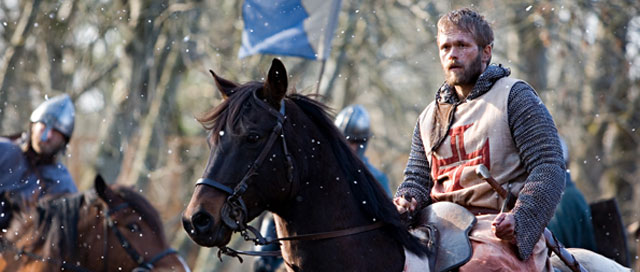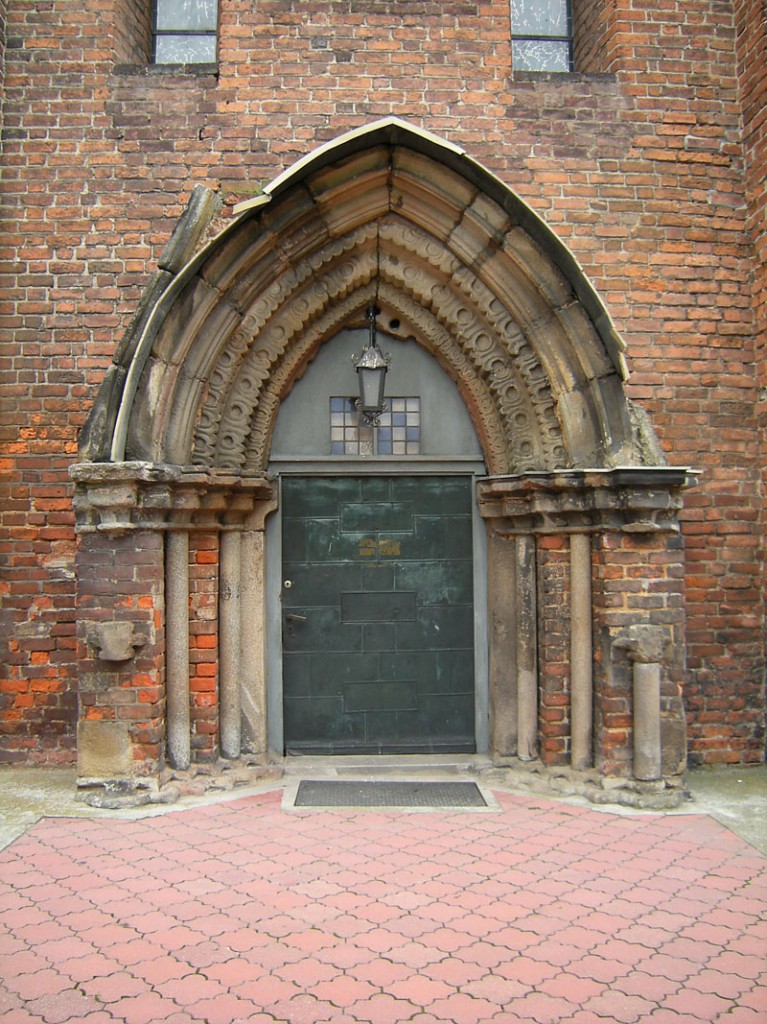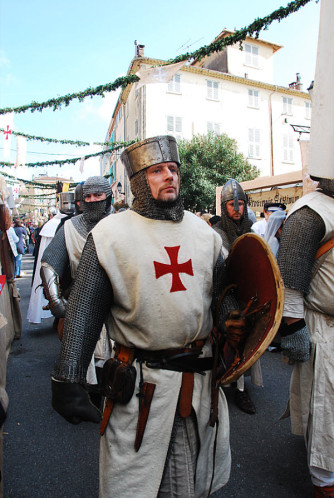
Anyone reasonably well versed in medieval history should be able to produce a list of some illustrious (and sometimes ignominious) members of the Knights Templar Order. Sure enough, in popular culture (books, movies, video games) these men are often ascribed deeds and character traits that probably had nothing to do with reality, but they remain actual historic figures no matter what. However, these historic Knights Templar are often outdone is bravery, wisdom and mischief by the Templars who never existed. It is time these characters are cataloged, lest someone assumes them to be real medieval warrior monks.
Arn
Arn Magnusson is a Swedish Templar featured in the series of novels by Jan Guilou. Movie adaptations of these novels (2007 and 2008) faithfully depict Guilou’s story of Arn who has since become perhaps the most beloved fictional Templar ever.
Larmenius
Brother John Mark (Jean-Marc) Larmenius of Jerusalem was the supposed author of the document currently known as the Larmenius Charter. The provenance of this document is extremely uncertain and its authenticity is doubted even by the masonic and neo-Templar organizations that use it as a part of their lineage claims. The charter insists that Jacques de Molay made Larmenius his secret successor as the leader of the Order. Thus the Knights Templar managed to survive the persecutions and the undercover Order has been in existence ever since. Some people today believe that even though Larmenius himself never existed, the document hints at what really happened to the Order of the Knights Templar.
Brian de Bois-Guilbert
Brian de Bois-Guilbert is one of the main characters in Walter Scott’s novel Ivanhoe. Brian is a villain, driven by greed and lust. It can be argued that Walter Scott’s portrayal of this Templar commander has been influenced by the grim and grotesque legends about the Knights Templar which used to be especially popular in Northern France.
Thomas Marshall
In the 2011 film Ironclad, Thomas Marshall is a Templar Knight who joins the struggle of some English nobles against King John. This heroic and somewhat troubled character is very loosely based on William Marshall 2nd Earl of Pembroke whose family had close ties with the Knights Templar.
Martin of Carmaux
In Raymond Khoury’s novel The Last Templar, Martin of Carmaux is a young knight who is charged with the task of protecting the greatest secret of the Order.
It may seem that this list is short. Please suggest any names that are worthy of being included here. At the time of writing, the biggest hope for any Templar fan is that the new History Channel production Knightfall will create some very memorable characters.
See also:
Famous Knights Templar
How can one become a Knight Templar?
 This story can be found, along with many other fascinating tales, in Legends of the Knights Templar.
This story can be found, along with many other fascinating tales, in Legends of the Knights Templar.
A local legend in Maryculter, Scotland, tells of a Knight Templar named Godfrey Wedderburn. who went on a Crusade to the Holy Land and was so eager to fight the enemy that he challenged a Saracen commander to a single combat before the battle began. In that duel, he received a serious wound and was left for dead on the battlefield.
When Godfrey regained consciousness, he made his way to a nearby well. There he was discovered by a native girl. She happened to be the daughter of the Saracen leader with whom the knight had fought. The two fell in love with each other and the Saracen girl nursed the Knight Templar back to health, acting in secret from her own family. As a sign of love, she gave him a golden ring. But staying true to his vows, Godfrey could not marry her. He had to return to the Knights Templar and was eventually stationed in his native Maryculter.
The Saracen girl, of her own accord, followed Godfrey to Scotland. Prepared to declare her love for the Christian knight, she entered the grounds of the preceptory in Maryculter, only to be violently thrown out by the Master of the Templar house. Upon seeing this treatment, Godfrey became outraged and attacked his commander, knocking him to the ground. The rebellious knight was arrested and sentenced to death.
The day of Wedderburn’s execution came. For his disobedience, he was slain with his own dagger. At that moment his Saracen sweetheart appeared out of nowhere in the middle of a closely guarded Templar compound and threw herself down on Godfrey’s lifeless chest. Tearful, she took the golden ring off the knight’s finger and offered it to the Master. Perplexed, he put it on and was immediately struck down with a bolt of blue fire. The maiden seized Godfrey’s dagger and killed herself. Wedderburn’s body was buried inside the Templar chapel. A white ghost with raven hair could sometimes be seen hovering above his grave.
The photo submitted by Barnnicus Habek
See also:
How can I become a Knight Templar? One of the most frequently asked questions!
Legends of the Knights Templar Obscure historic narratives and local legends about the Order.
 In the village of Kałków (Southwestern Poland) there is a church which was, according to the local tradition and the inscription that can no longer be seen, built by the Knights Templar. The church’s remote location would have made it suitable for keeping treasures and secrets. The legend has it that when King Philip the Fair of France started his campaign against the Knights Templar, but failed to appropriate their wealth, he was determined to search far and wide. The Church of St. George in Kałków became a target for the King’s next strike. They say that this time Philip IV directly requested assistance from Satan himself. The enemy of mankind came to Kałków with the intention to lift the entire church building from its foundation and deliver it to the French monarch with everything that was inside it. However, first he had to overcome St. George, the church’s patron. Their battle lasted all night. Several times during the struggle Satan attempted to grab the church and pick it up, but his efforts were thwarted by St. George. The Evil One was forced to flee at the cry of the first rooster. To this day, there is a mark left by Satan’s claw near the entrance into this church.
In the village of Kałków (Southwestern Poland) there is a church which was, according to the local tradition and the inscription that can no longer be seen, built by the Knights Templar. The church’s remote location would have made it suitable for keeping treasures and secrets. The legend has it that when King Philip the Fair of France started his campaign against the Knights Templar, but failed to appropriate their wealth, he was determined to search far and wide. The Church of St. George in Kałków became a target for the King’s next strike. They say that this time Philip IV directly requested assistance from Satan himself. The enemy of mankind came to Kałków with the intention to lift the entire church building from its foundation and deliver it to the French monarch with everything that was inside it. However, first he had to overcome St. George, the church’s patron. Their battle lasted all night. Several times during the struggle Satan attempted to grab the church and pick it up, but his efforts were thwarted by St. George. The Evil One was forced to flee at the cry of the first rooster. To this day, there is a mark left by Satan’s claw near the entrance into this church.
This image by Stok appears to be of that exact entrance to the church. You can judge for yourself!
 The Knights Templar preceptory in Nice (Provence) dated back to as early as 1135. According to one local legend, the first Templar to reside in the area acquired his fortune in a battle with the devil himself. An even more elaborate story exists about the final days of the Knights Templar in Nice. When in 1307 subordinates of King Philip arrested the Knights Templar all over France, members of the Order stationed in Nice (not a French territory at the time) got an early warning about what was coming their way. The legend claims that a Templar chaplain by the name of Guillaume Auger Guigonis was in a secret amorous relationship with Bertrade d’Arlac, the daughter of Nice’s governor. The young woman knew about the calamitous fate of the Knights Templar in France. When she overheard at her father’s castle some conversations about similar measures that were going to take place in Provence she informed her sweetheart, and many knights were able to escape shortly before the arrests in Province began in January of 1308. Some people even believe that Bertrade also assisted Guigonis in finding a safe place for the Knights Templar treasure.
The Knights Templar preceptory in Nice (Provence) dated back to as early as 1135. According to one local legend, the first Templar to reside in the area acquired his fortune in a battle with the devil himself. An even more elaborate story exists about the final days of the Knights Templar in Nice. When in 1307 subordinates of King Philip arrested the Knights Templar all over France, members of the Order stationed in Nice (not a French territory at the time) got an early warning about what was coming their way. The legend claims that a Templar chaplain by the name of Guillaume Auger Guigonis was in a secret amorous relationship with Bertrade d’Arlac, the daughter of Nice’s governor. The young woman knew about the calamitous fate of the Knights Templar in France. When she overheard at her father’s castle some conversations about similar measures that were going to take place in Provence she informed her sweetheart, and many knights were able to escape shortly before the arrests in Province began in January of 1308. Some people even believe that Bertrade also assisted Guigonis in finding a safe place for the Knights Templar treasure.
Unwilling to part with Bertrade, the Templar chaplain did not leave Nice until the very last moment. He was eventually apprehended in Aix-en-Provence and was burned at the stake. On the very next morning after his execution Bertrade’s body was found on the rocks directly beneath her father’s castle.
In some modern accounts of this legend it is indicated that in 1822 a supposed tombstone was found among the ruins of the castle in Nice. It bore this inscription:
AG GB
+
EMMANUEL
HA IV MCCC VIII
I was unable to find any trustworthy sources regarding this inscription. For some reason it is construed to be related to the fate of the two lovers in this story. Some authors claim that the name “Emmanuel,” used in Isiah’s famous prophetic words about Christ the Savior, served as a password for Auger and Bertrade.
Image from freeriders2.over-blog.com





